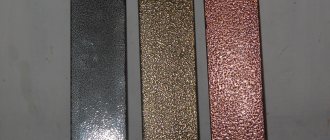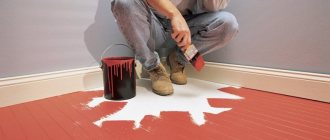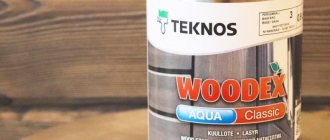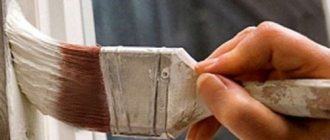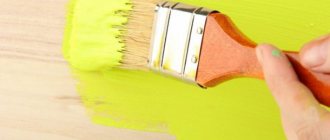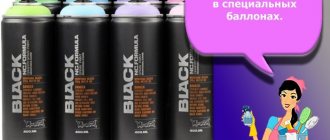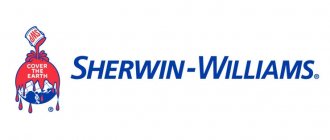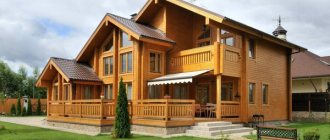Since the advent of universal latex, silicone and acrylic compositions with better characteristics, the popularity of oil paints has fallen sharply, but they continue to be used due to their relatively low cost and unique performance properties. Oil-based paint coatings can reduce repair costs, so the demand for them will never disappear.
What is oil paint
This material was created quite a long time ago, but still does not lose its relevance. Oil paint is intended for covering surfaces indoors or outdoors. The type and purpose of the product is always indicated by the manufacturer; you should pay attention to this when purchasing this type of paint.
Oil enamel contains natural vegetable oils and drying oil. Moreover, such paint is a relatively budget option, especially when you need to cover a large surface area.
Performance properties
The main wishes of the buyer when purchasing goods are their high quality. The same requirements apply to paint and varnish compositions. They are purchased not only for decorative purposes. Wooden products need protection from bacteria, fungus, and atmospheric factors.
An oil composition is perfect for this. Thanks to it, the tree acquires the following properties:
- durability;
- resistance to light;
- heat resistance and moisture resistance;
- protection against the appearance of fungi, pests and the spread of harmful microorganisms;
- breathability;
- protection against pollution;
- water repellent, protecting against rotting processes.
Oil-based wood coloring composition is an excellent decorative product for finishing buildings and objects inside and outside.
Painted objects can be cleaned with water without fear of spoiling their aesthetic and utilitarian qualities. Carrying out sanitary measures, on the contrary, will make them look attractive and shiny.
Where is paint containing drying oil used?
There are many areas of application for oil paints. It all depends on the composition and nuances of production. It covers:
- Walls.
- Roofs.
- Fences.
- Elements of garden interior.
- Benches, gazebos in parks.
Manufacturers produce oil paints for metal. When purchasing, you should pay attention to what surfaces this or that enamel is for.
Since the properties and composition of oil paints for walls differ significantly from coatings intended for wooden or metal surfaces. Moreover, it is important to look at the expiration date of this product. This is necessary because over time the paint changes its properties and may deteriorate towards the end of its shelf life.
Color palette of most coatings
If the substance is used as a primer, its color does not matter. In other cases, the shade of the coating matters. Oil paints have a wide palette. The properties and characteristics of oil paints also determine the buyer’s choice.
Coloring pigments
The color of the paint depends on the pigments in its composition. They are organic and inorganic.
Regardless of their origin, coloring pigments are found in the following shades:
- beige (120);
- blue (100);
- yellow (140);
- green (100);
- brown (100);
- red (65);
- light or pale blue (100);
- fawn (160);
- light green (140);
- gray (100);
- blue (100);
- ivory (200);
- dark red (100);
- pistachio (135).
In parentheses next to each pigment is the value of its hiding power for the painting consistency. Unit of measurement – g/m².
If the coating contains 1 coloring pigment, then the name of the paint color and the designation of the pigment shade will be the same.
In search of unusual color solutions, some combine 2-3 compositions with each other. There is a special color table with which you can check your experiments, since oil paints cannot be mixed with each other in any shade.
Advantages of oil paint
Among the advantages of this material:
- Budget cost.
- Moisture resistance.
- Protective functions. These properties are especially good for wooden surfaces on which fungi and mold will not develop.
- Possibility to wash surfaces coated with oil enamel.
- Easy to apply.
- Economical consumption. The paint can be applied in one layer, and the coating will be of high quality.
- Wide range of shades.
Moreover, one of the main characteristics of oil paints is the possibility of even application, without streaks. And also environmentally friendly. Oil enamels are safe because they are made from natural ingredients.
In addition, such paints are resistant to temperature changes. Therefore, this material is indispensable when processing the facades of buildings and structures.
Club Young Chemist
Is it possible to make your own oil paints?
Technically this is possible. The economic feasibility of the experiment is questionable: some of the reagents will have to be found, and their cost is not so low; In addition, the quality of the dye at the output will be noticeably inferior to industrial products. However... Leonardo and Galileo were also driven only by curiosity, weren’t they?
Here are the simplest instructions for preparing oil paint.
Drying oil
Of course, you can just buy it. However, this idea is clearly flawed, runs counter to our plans to satisfy our curiosity in the field of chemistry and may even lead us to buying ready-made paint. (See also the article Wall decoration: options.)
Let's nip it in the bud.
- Place 50 grams of rosin (you can find it at a radio parts store) in a porcelain or metal bowl.
The main component of the dryer is rosin.
- Place the dish in the oven and allow the rosin to completely melt at 250 degrees.
- Remove the melt from the oven and, while stirring continuously, add 5 grams of CaO (quicklime, “boiling liquid”) into it.
- The resulting mixture is again placed in the oven and heated there until clear. No, no, we are not talking about the spiritual perfection of the reagent: a drop of the mixture placed on glass should become absolutely transparent as a result of the reaction. As soon as this happens, the desiccant (calcium resinate) is ready.
- To obtain the finished drying oil, all that remains is to mix the drying agent with linseed oil heated in the oven to 200 degrees. The proportion is 3-5 parts of calcium resinate per 100 parts of oil.
Attention: upon contact with water, the oil boils instantly. Splash burns are very painful. It is better to mix drying oil components with thick rubber gloves, glasses and an exclusively dry object.
A dry wood stick is used for mixing.
Pigment
For this purpose we have to use zinc white.
- We lower the glass from the discharged battery into concentrated hydrochloric acid. It can be found in hardware stores as a cleaning agent for earthenware plumbing fixtures.
- We are waiting for the zinc cup to completely dissolve. Before us is an acid solution of zinc chloride ZnCl
- Gradually add an aqueous solution of washing soda to the container. After the neutralization of the acid, which is accompanied by a violent reaction, a precipitate will begin to form in the dishes - zinc carbonate ZnCO3.
- The precipitate is filtered and calcined at a temperature of at least 280 degrees (for example, in the flame of an alcohol lamp). At the same time, it breaks down into carbon dioxide CO2, which immediately evaporates, and zinc white ZnO.
All that remains is a mere trifle: add about 30 volume percent talc (baby powder) and pigment to the drying oil with thorough mixing until a rich white color is obtained.
Baby powder will serve as a filler for paint.
Oil paint has disadvantages
This enamel takes a relatively long time to dry. The downside is that during the drying process, particles of dirt, dust, and small insects stick to the surface. In addition, oil paint is often intended for outdoor use, as it has a rather strong smell.
- This enamel is practically non-hygroscopic, i.e. does not conduct air.
- The surface covered with oil paint is provided with a kind of armor through which no substances can pass.
- If the layer was not applied according to the rules, this property can provoke the occurrence of condensation and, as a result, the appearance of mold.
Enamel created on the basis of drying oil is relatively short-lived. It begins to crack and change color. The surface will have to be painted again in a couple of years. It is often necessary to update the façade much earlier than this in order to give it an aesthetic appearance.
Recommendations for coloring
After treating the surface, the painting process can only bring a good mood.
Now that the negative properties of drying oil have been minimized as much as possible, it’s time to begin the procedure of painting or pasting the surface.
Painting work is carried out in several stages at temperatures from –30 to +40 degrees and relative air humidity not higher than 80%:
- To begin with, hard-to-reach places, welds, and end edges are painted with a stripe layer with a brush.
- The painting solution is applied in one layer using vertical movements, direction from left to right or from the wall farthest to the door with a roller, brush or spray (at a distance of 20-30 cm). It is also possible to dip the object into the paint paste. Wait until it completely dries.
- Metal surfaces are painted in 2–3 layers and dry for up to 3 hours; cement-sand, asbestos-cement and concrete surfaces should be painted in 3 layers, and wooden surfaces – 1–2.
- Rinse the dried surface with hot water (without adding soda or detergent) to remove stains. Wipe again before use.
- You can get rid of the persistent smell of some types of paints (for example, oil paints) by placing 2-3 jars of salt water or grated garlic on a plate next to the painted area or in the room.
It is very important to wait until each previous coat of paint is completely dry before applying the next one. The final drying time of the finished coating at a temperature of +20 degrees is at least 24 hours.
You can check whether the surface has dried or not, perhaps using the traditional method - by placing your finger on the area of painting. If necessary, you should wait a longer period.
Transforming an oiled surface is not the easiest task. But with a skillful approach and competent selection of the necessary tools and finishing materials, in just a few days you can revive the interior and give it a new, more attractive look that will delight its diligent owner for a long time.
What is the consumption of this enamel
The higher the absorbency of the surface, the more paint will have to be used when painting it. The percentage of consumption also depends on the thickness of the enamel.
On average, experts talk about a consumption of 150-170 g per square. Moreover, processing metal will require a smaller amount of drying oil, but wood will take up the enamels to the maximum.
How long does oil enamel take to dry?
The drying process takes at least a day. Some manufacturers guarantee complete drying 12-13 hours after finishing work with paint. But more often this process takes up to 30 hours.
- By the way, the drying time depends on the composition and thickness of the oil substance.
- The more concentrated it is, the faster the fixation process will take place.
- Some manufacturers recommend mixing the material with other components.
How to thin oil paint? If there are no specific instructions on the package, thick oil paint is brought to the desired condition with white spirit or turpentine. The additive should be no more than 5 percent by volume of the total mass.
Marking features
There are domestic standards based on which all paints and varnishes are labeled. Oil paints are designated "MA". In addition to letters, there are also numbers on the label of a paint can. The first number indicates the area of application of the composition. If it is “1”, then the material is weather resistant. If “2” is a product suitable for painting surfaces in enclosed spaces.
The second number is the type of drying oil, which can be:
- pentaphthalic;
- glyphthalic;
- composite;
- oxol;
- natural.
There are special varieties for wood and metal.
Oil paint composition
It is simple and includes a minimum of components. Oil paint consists of drying oil and dye. Literally 20 years ago, manufacturers used absolutely natural ingredients, “extracted” from plants. These are essential oils that were the basis of drying oil.
Modern manufacturers have learned to make synthetic drying oil. It doesn't smell as strong and dries much faster. Recently, factories have been mixing natural and artificially created drying oils to obtain an even higher quality oil mass.
Depending on the proportions in which these and other components are used, the following types of oil paint are distinguished:
- Natural.
- Combined.
- Pentaphthalic.
- Alkyd.
- Oxol.
The pigments used are usually natural. These are ocher, zinc, lead, and other coloring minerals.
How to choose oil paint
Before purchasing such products, you should pay attention to the information provided on the packaging. Volatility characteristics should not exceed 10%, otherwise the paint will emit too strong an odor.
There should be about 25% of film-forming substances responsible for the density of the composition. The denser the emulsion, the better the quality.
In addition, it is important to consider the following indicators:
- Particle grain size is at least 90 microns.
- Viscosity – not lower than 60 units.
- Approximate consumption per square meter – at least 150 g.
The packaging will indicate the drying speed, which is also worth paying attention to.
Procedure for working with oil paint
The old coating should be removed from the surface, sanded, cleaned, degreased, and dried. Then fill the cracks with putty and go over a couple of layers of primer.
It is better to apply the oil paint itself in a thin layer. If you need to do a second staining, the first tier must be thoroughly dried.

